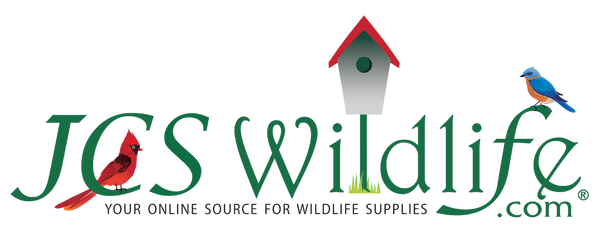While your birds may be enjoying the sunshine, some more pesky organisms may be basking in your bird bath or eating at your feeder--waiting for the perfect time to take over. During the summer months, it is important to regularly clean your bird feeders and bird baths in order to keep your feathered friends safe from parasites, mold, and diseases that flourish in wet warm areas.
Seed and Suet Feeders
Cleaning the bird feeders in your garden is simpler than you may think! Your feeders should be cleaned at least once every two weeks, and more often during times of heavy use or after rainy weather resulting in wet seed buildup. This helps your garden stay safe from moldy seed (which can make your birds sick) as well as minimize any transmission of common bird diseases like E. coli or Salmonella. If you are using a feeder with small crevice where seed can hide, take it apart if possible and remove all debris before cleaning. Then, wipe away any bird droppings on the outside and soak your feeder to loosen any stuck-on grime. After soaking, use a natural product like the Bird Feeder Cleaner from Care Free Enzymes or with a diluted bleach solution (no more than 1 part bleach to 9 parts water, but 10% bleach is most common) to clean and air dry the feeder completely before refilling.

During the summer, fill your feeders with smaller quantities and clean between each refill, which prevents seed waste and minimizes spoilage. Cleaning up the ground around your feeders also keeps your yard clear of hulls and unwanted seed piles that may harbor bacteria. This discourages birds and other outdoor animals like pets from eating spoiled seed. Or, in one customer's case, you won't find new plants sprouting underneath your feeder months later! Adding feeders with removable seed trays like our Fly Thru and Large Hopper models also allow for easy cleaning and refilling, featuring drainage holes that keep your seed dry and less susceptible to seed buildup.
Nectar Feeders
When feeding hummingbirds in the summer, it is important to remember what is in their nectar, and why your feeder should be cleaned often. Since hummingbird and oriole nectars are ratios of sugars and water, if left outside in the hot sun for long periods it will ferment and spoil. The liquid inside can also evaporate and the sugars crystallize in the base and ports of your feeder, which can make refilling a huge hassle. Due to these factors, hummingbird and oriole nectar feeders should be cleaned at least once a week, and the nectar inside should be changed every 3-5 days to prevent fermentation and mold.
Clean your feeder using either dish soap and water or a specialized product like the Care Free enzymes Hummingbird Feeder Cleaner. Using cleaning tools like the JCs Wildlife Ultimate Feeder Cleaning Brushes ensure that sticky residue is removed from your feeder with a large dual-ended bottle brush, as well as another smaller brush to access ports and small crevices. Once the feeder is cleaned, allow it to air dry and then you'll be free to refill and feed your hummingbirds again!
Monitoring the nectar levels in your feeder is key to minimizing waste while ensuring that your hummingbirds are fed safely. If you notice that your hummingbirds are feeding less often during summer, consider a smaller feeder that can be emptied by your birds within 3-5 days or even feeders like our DOTS products that can be easily washed and refilled as needed. For example, the Nectar DOTS Heart Hummingbird Feeder comes with two Nectar DOTS, so you can easily place a full container in the feeder while you wash the other-- that way, the hummingbirds won't miss a beat.
Bird Baths
Just like a person dipping their feet in the pool, birds like to stay cool with bird baths! Keeping a few inches of clean water for the birds in your garden will provide a small oasis where they can relax. When choosing a bird bath, the bowl should be filled with only up to 2 inches of water and should be placed in a shady area in order to keep it cool. Since many different birds can use your bird bath, changing the bath water every few days and regularly cleaning your bath will maintain a safe drinking and bathing area. In order to keep birds visiting regularly while keeping pests like mosquitoes from laying eggs inside, keep your bird bath water moving. This may be accomplished by adding a dripper, a fountain, or a device like the Allied Precision Solar Water Wiggler which keeps your water from getting stagnant. Birds can't resist the sound of moving water, which entices them to stay and cool down.
In order to clean your bath, empty out any stagnant water and remove debris from the bowl. Then, wash the bowl as well as any areas where birds can perch and rinse completely. Once your bowl in cleaned, ensure that the rest of the bird bath exterior is free of any contaminants like droppings and then you're free to fill it back up! For baths made with cement or other porous materials, use a cleaner like the Care Free Enzymes Bird Bath Statuary Cleaner so that bacteria won't harbor inside.
No matter how you choose to entice your birds this summer, taking extra precautions during the hotter months can ensure that your birds will want to visit for many seasons to come. Check our some of our JCs Wildlife Exclusives to see how you can turn your yard into a garden getaway for your feathered friends.
Follow us on Facebook, Twitter, and Instagram to connect with the wildlife in your area!
How to Clean Bird Feeders and Bird Baths During Summer


